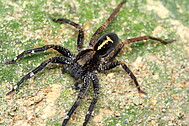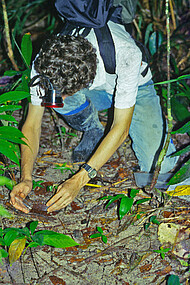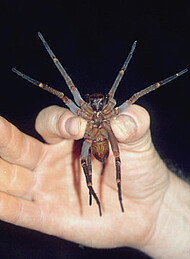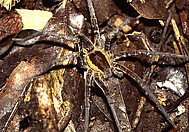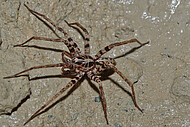Amazonian Ctenidae - introduction
During nocturnal excursions in dryland (terra firme) forests of the Central Amazon region in Brazil several large wandering spiders can be observed. Ctenid spiders (Ctenidae), also called tropical wolf spiders, are the most characteristic tropical rainforest dwellers.
Phoneutria and Ancylometes species are the most impressive – being as large as an open hand. The medium sized Ctenus are the most abundant - within few meters, many individuals can be found on the ground. And there are several species of less the known genera Acanthoctenus, Asthenoctenus, Centroctenus, Enoploctenus, Gephyroctenus and Cupiennius.
Together, these are important predators of insects, other arachnids and even small vertebrates in the Amazon forests. The wandering spiders not only compete for food, they also frequently prey on each other, which is called intraguild predation. Due to their abundance this interaction is an important part of their lives and this makes them an interesting subject to study and understand the coexistence of species and the maintenance of high diversity.
The spiders start their activity about one hour after sunset. Their eyes shine reflecting the light of headlamps, which makes it easier to detect them. Their abundance is generally lower in the dry than in the wet season. There are months when most genera are easy to find and months when even the most abundant species almost disappear. The reason for this variation is still not clear, as their numbers start do increase during the dry season, showing that this is not an unfavorable season.
To find the largest ctenids one has to go to the small streams within the forest. The giant fishing spiders Ancylometes rufus are very abundant on their banks, especially during the dry season. During the rainy season they disperse, but always stay close to small water bodies. The other species Ancylometesterrenus is much more difficult to find, because it lives in burrows distant to streams, but also near ponds. The other large ctenids also differ in terms of abundance in the different habitats. Phoneutria reidyi is much more frequent in areas close to streams, while P. fera is more frequent in areas far from streams. Both species make more use of the vegetation and are therefore more difficult to detect, although they are possibly as abundant as Ancylometes. Females of all these species lay hundreds of eggs in each clutch, of which only a small proportion survive the 2 - 3 years to become adult.
To find many Ctenids, one has to look on the ground. That’s where the Ctenus, Centroctenus and most juveniles of Ancylometes stay. The most abundant species are where most of the food is - in the leaf litter. However, this is also the most dangerous place to be. To escape from predators Ancylometes rufus can dive and stay under water for many minutes and Phoneutria jump from the vegetation or hide on the base of spiny palms. Some species hide in burrows, like Centroctenus species and A. terrenus, others are very well camouflaged, like the litter dwellers Enoploctenus spinipes and Gephyroctenus philodromoides. The main strategy on the ground and in leaf litter is to hide, run fast and hide, but hiding is useless if the predators are army ants.
To observe all the different ctenid species, you have to train your eyes on many excursions or use special traps, you may need patience and luck. We captured many Gephyroctenus with arboreal fotoeclectors, a trap that captures spiders moving on trunks, but we have rarely seen the spiders alive. We passed years until discovering the first Acanthoctenusspinipes and still spend months without finding one. Acanthoctenusspinipes and Cupiennius bimaculatus are not so rare, but one is lucky finding an adult during the first nocturnal excursion. Asthenoctenus longistylus seems to prefer the swimming grass aglomerations around inundated forests (várzea).
This is the description of the ctenid assemblage near Manaus. Take a head-lamp with you and you will make similar discoveries all over the Amazon, in the Brazilian Atlantic Forests and even in Central America. There will be different species and even genera, but the Ctenidae will be the dominant wandering spiders in any Neotropical rainforest.


